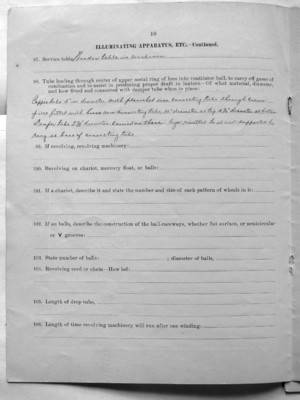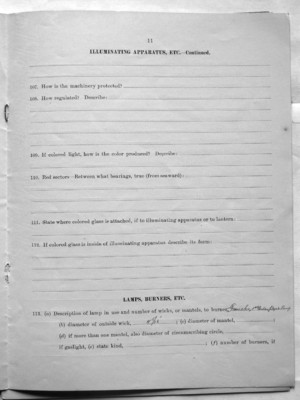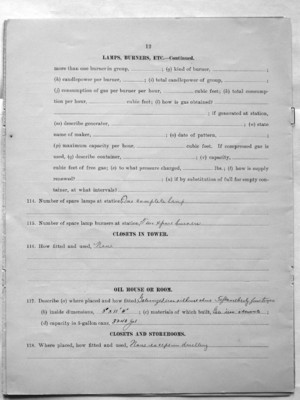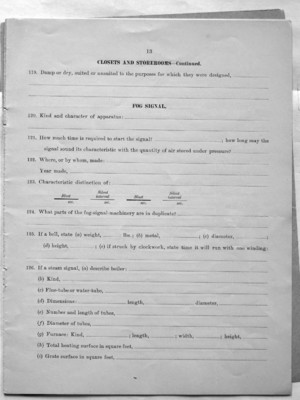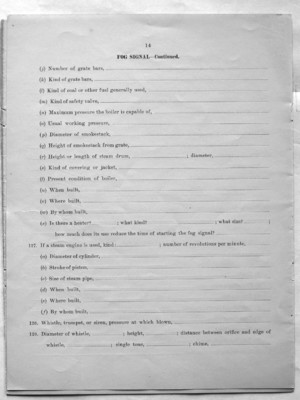Pages
11
Illuminating Apparatus, Etc.—Continued. 97. Service table, Wooden table in workroom 98. Tube leading through center of upper metal ring of lens into ventilator ball, to cary off gases of combustion and to assist in producing proper draft in lantern—Of what material, diameter, and how fitted and connected with damper tube when in place: Copper tube 5” in diameter with planished iron connecting tube through brown piece fitted with base arm connecting tube 10” diameter as top 5 ¼” diameter as bottom damper tube 3 7/8” diameter carried on huge riveted to is and supported by ring at base of connecting tube 99. If revolving, revolving machinery: _____________________________________________ 100. Revolving on chariot, mercury float, or balls: ___________________________________ 101. If a chariot, describe it and state the number and size of each pattern of wheels in it: _________________________________________________________________________ 102. If on balls, describe the construction of the ball-raceways, whether flat surface, or semicircular or V grooves: ___________________________________________________ 103. State number of balls: (None); diameter of balls, ________________________________ 104. Revolving cord or chain—How led: ___________________________________________ 105. Length of drop tube, _______________________________________________________ 106. Length of time revolving machinery will run after one winding:
12
107. How is the machinery protected? ____________________________________________ 108. How regulated? Describe: _________________________________________________
109. If colored light, how is the color produced? Describe: ___________________________ 110. Red sectors—Between what bearings, true (from seaward): ______________________
111. State where colored glass is attached, if to illuminating apparatus or to lantern: ______
112. If colored glass is inside of illuminating apparatus describe its form:
Lamps, Burners, Etc. 113. (a) Description of lamp in use and number of wicks, or mantels, to burner, Funcks, 1st Order float lamp (b) diameter of outside wick, 4 5/16; (c) diameter of mantel, (None); (d) if more than one mantel, also diameter of circumscribing circle,_________ If gaslight, (e) state kind,_______________; (f) number of burners, if
13
Lamps, Burners, Etc.—Continued More than one burner in group,____________; (g) kind of burner,__________; (h) candlepower per burner,________; (i) total candlepower ofgroup,_________; (j) consumption of gas per burner per hour,¬¬¬¬¬¬¬________ cubic feet; (k) total consumption per hour,____________ cubic feet; (l) how is gas obtained? _______________; if generated at station, (m) describe generator,______________; (n) state name of maker, ________; (o) date of pattern,__________; (p) maximum capacity per hour,_____________ cubic feet. If compressed gas is used, (q) describe container,____________; (r) capacity,____________ cubic feet of free gas; (s) to what pressure charged,__________lbs.; (t) how is supply renewed?_______________; (u) if by substitution of full for empty container, at what intervals? ____________ 114. Number of spare lamps at station, One complete lamp 115. Number of spare lamp burners at station, Five spare burners Closets in Tower. 116. How fitted and used, _______________________________________________________ Oil House Or Room. 117. Describe (a) where placed and how fitted, Galvanized iron oilhouse about 50 ft. northerly from tower (b) inside dimensions, 8’ x 11’ 4”; (c) materials of which built, Galvanized iron & concrete
14
(d) capacity in 5-gallon cans, 3240 gal Closets And Storerooms. 118. Where placed, how fitted and used, None except in dwelling Closets And Storerooms—Continued 119. Damp or dry, suited or unsuited to the purpose for which they were designed, ______________________________________________________________________________Fog Signal 120. Kind and character of apparatus:________________________ 121. How much time is required to start the signal? _______________________; how long may the signal sound its characteristic with the quantity of air stored under pressure? ___________ 122. Where, or by whom, made:_____________________ Year made ___________ 123. Characteristic distinction of: __________________________________________________ Blast Silent interval Blast Silent interval sec. sec. sec. sec. 124. What parts of the fog-signal machinery are in duplicate? ___________________________ 125. If a bell, state (a) weight, _______ lbs; (b) metal, __________; (c) diameter, ________; (d) height, ________; (e) if struck by clockwork, state time it will run with one winding: ______________________________________________________________________________ 126. If a steam signal, (a) describe boiler: ____________________________________________ (b) Kind, _____________(c) Flue-tube or water tube, __________________ (d) dimensions: ________ length, ________ diameter, _____________ (e) Number and length of tubes, ____________________________
15
Fog Signal – Continued. (j) Number of grate bars, (k) Kind of grate bars, (l) Kind of coal or other fuel generally used, (m) Kind of safety valve, (n) Maximum pressure the boiler is capable of, (o) Usual working pressure, (p) Diameter of smokestack, (q) Height of smokestack from grate, (r) Height or length of steam drum, ___________; diameter, _______________ (s) Kind of covering or jacket, (t) Present condition of boiler, (u) When built, (v) Where built, (w) By whom built, (x) Is there a heater? ________; what kind? ________; what size? _____________; how much does it use reduce the time of starting the fog signal? ________________ 127. If a steam engine is used, kind: ____________; number of revolutions per minute, _____ (a) Diameter of cylinder, (b) Stroke of piston, (c) Size of steam pipe, (d) When built, (e) Where built, (f) By whom built, 128. Whistle, trumpet, or siren, pressure at which blown, ___________________ 129. Diameter of whistle, __________; height, _______; distance between orifice and edge of whistle, ______; single tone, ___________; chime, ______________
